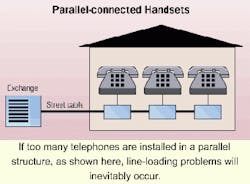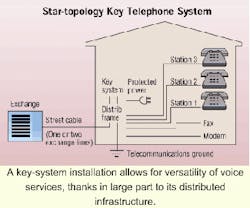Small telephone switching systems can be advantageous in small-business and residential environments.
The home environment is rapidly becoming an important market segment for the cabling installer, as many families now have multiple telephone lines. Multiple telephone lines are becoming increasingly popular, and necessary, for a couple of reasons:
- The changing nature of how we work allows many people to work from home, and the home office environment is now common. Home-office requirements usually include Internet access as well as fax and voice communications.
- The huge demand for personal Internet access, generally after normal business hours, means that a single line is often inadequate for family home needs.
Given the expense associated with the installation and ongoing rental of a second line, a small key system often can add functionality to make better use of such an investment. Likewise, for most small businesses, the functionality offered by a key system can improve efficiency in terms of the way the business operates. Additionally, a key system can give a small business a more professional appearance to the outside world.
Key system vs. POTS
To better understand key systems, it is appropriate to review the types of service offered by standard telephone handsets.
The most basic type of telephone service configuration is commonly known as plain old telephone service (POTS). A POTS consists of a single exchange line terminated on a single telephone handset. This was by far the most common arrangement for home installations in the past.
A basic enhancement to POTS is to provide additional parallel-connected sockets at other locations within the same premises. The telephone is then moved from one location to another as necessary.
The next step up is to have more than one handset connected in parallel. This setup can cause some problems with line loading as the number of handsets grows, especially if the handsets are of different design. Some older handsets load the line markedly and do not work well in parallel with more modern electronic instruments.
If electronic handsets of the same type are in place, three or four instruments in parallel can be made to work satisfactorily. One disadvantage of this setup is that there is no indication on any of the instruments as to when the line is in use. Also, undetected eavesdropping from a parallel-connected instrument is possible.
The basic function of a key system is to offer access to one or more exchange lines at more than one location, not necessarily on the same premises. Another basic function is to offer enhanced call-management features beyond what is offered by standard telephone handsets and POTS.
The number and type of features, and the line and station capacity offered by the key telephone system, will depend on the system's make, model, and age.
Installation basics
A key system physically consists of a "black box," which contains a small computer. It is usually wall-mounted, often near the point where the carrier's cabling terminates within the premises. From there, star-topology cabling radiates to all the required handset locations.
Some older key systems require up to three wire pairs per station to operate, so it is worth checking for this before commencing an installation. Most modern systems, however, get by using a single pair.
Of course, main power and a telecommunications earth /ground are also required at the black box. Although the black box draws very little, a dedicated mains circuit is worthwhile. For an investment of a few hundred dollars, some form of surge protection from the mains power and lightning protection on the exchange-line side is highly recommended.
It is usually expensive to repair a key system that has been damaged by a surge, because the system's motherboard usually is damaged. The motherboard sometimes can cost as much as an entirely new system. Consider, however, that the cost to the business of having the telephone system down for a day or more may far exceed the repair bill.
Inside the box
A key system is basically a small computer. Call traffic is digitized and switched digitally within the black box. Station handsets can be thought of as terminals hanging off the key system computer.
Programming the system features can usually be carried out from one of the more advanced handsets. System configuration and other advanced parameters are set up via a port where a laptop or PC running custom software may be plugged in.
The system usually is configured physically by plugging specific-function station cards into the motherboard. For example, door stations, standard stations, and stations capable of operating a standard telephone, fax, or modem are all likely to require different cards.
Key systems normally require dedicated, system-specific station handsets. Thus, station handsets generally are not interchangeable between different makes of key systems, and often not even between different models of the same maker. So, a key-system station handset will not work when plugged into a standard exchange line. This is also why a computer modem will not work when plugged into a key station socket.
Most key systems offer a choice from a range of different handsets. The more advanced handsets offer features such as hands-free operation and multi-line display. On smaller systems, most handsets provide sufficient buttons to permit one-button access to all system stations and exchange lines.
Top-of-the-line handsets may sometimes be fitted with one or more add-on plinths, which provide access to approximately 50 additional buttons. This plinth is commonly used for the receptionist position on larger systems, where a normal handset does not have sufficient buttons to permit one-button access to all stations.
Many key systems also offer as an option the ability to operate using a normal telephone handset as a station handset. This option usually requires a different card in the system box, and limits the functionality of the station or stations so equipped. It does, however, permit a modem, fax, or answering machine to be used with that particular port.
System functions
Some basic functions of key telephone systems include multi-line operation, station-to-station calls, call hold, call pickup, and call transfer.
A key system can be installed with just one exchange line and still provide many useful enhancements over POTS. But it really comes into its own when more than one exchange line is fitted. In the later configuration, all connected exchange lines are accessible at each station.
With this multi-line operation in place, all stations are aware of the status of each exchange line-busy, free, or on hold. Conferencing of calls with more than one station is also possible. This setup is similar to the parallel telephone setup possible with POTS, but without the line-loading and call-security problems. Some models also allow call conferencing on two exchange lines.
It is also possible to make station-to-station internal calls. Such calls are free, as the call does not go out into the public telephone network. Intercom-style operation between stations is possible on many systems, but this function requires handsets with hands-free capability.
Incidentally, it is not necessary to locate all stations within the same premises. Outdoor distant extension operation is possible, although the circuit usually will have to use the carrier's network once it leaves the premises.
Someone's at the door
A particularly useful type of intercom call can be made in conjunction with a handset known as a door phone. The door-phone handset does not have a dial pad or a receiver. Rather, it looks like an intercom station, operating hands-free and equipped with a call button. It is designed to be mounted outside the premises, adjacent to an access door. When someone wishes to gain entry to the premises, that person presses the call button. An intercom call is thus established to one or more stations within the premises.
On some systems, remote electronic lock activation is also possible, again as a dedicated station function. Hence, when someone calls on the door phone, the door may be unlocked remotely if required.
On most systems, it is possible to place a call on hold. This feature is used when making an internal inquiry or making another call. When a call is placed on hold, music-on-hold (MOH) is applied to the caller's line, giving the caller confidence that the call has not been lost or disconnected. MOH is usually provided by the system, either from an internal source or through the provision of a port into which an alternate source may be connected.
Under normal circumstances, an incoming call on any exchange line may be picked up from any standard station. The call is usually annunciated either by a common bell ringing, or by all handsets ringing. Also, visual indication of an incoming call is available on all handsets.
Where incoming calls initially appear is a programmable feature. Sometimes the preferred mode of operation is for all incoming calls to go to a particular station, normally the receptionist. The call is then picked up and can be transferred via a dedicated call-transfer button. During the process of call transfer, MOH is automatically connected to the caller.
This process is similar to that of a PABX switchboard operation, and gives the caller the knowledge that the call has not been lost.
Editor's note: This article also appeared in Cabling Installation & Maintenance Australia/New Zealand.
George Georgevits manages Power and Digital Instruments Pty Ltd., an Australian communications-engineering consultancy specializing in laboratory and field testing.


